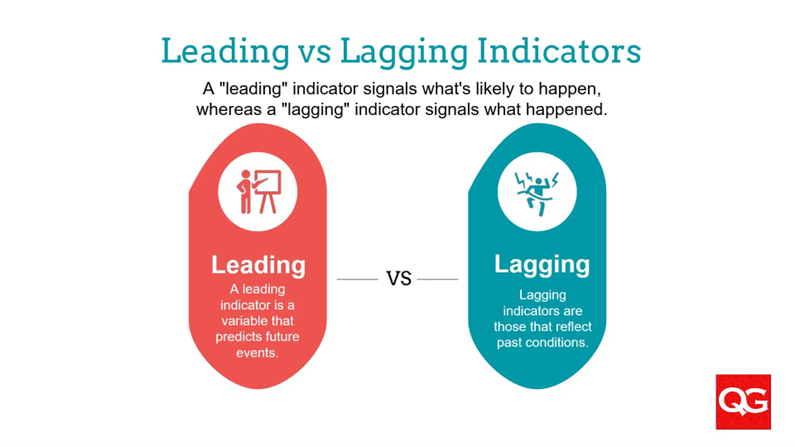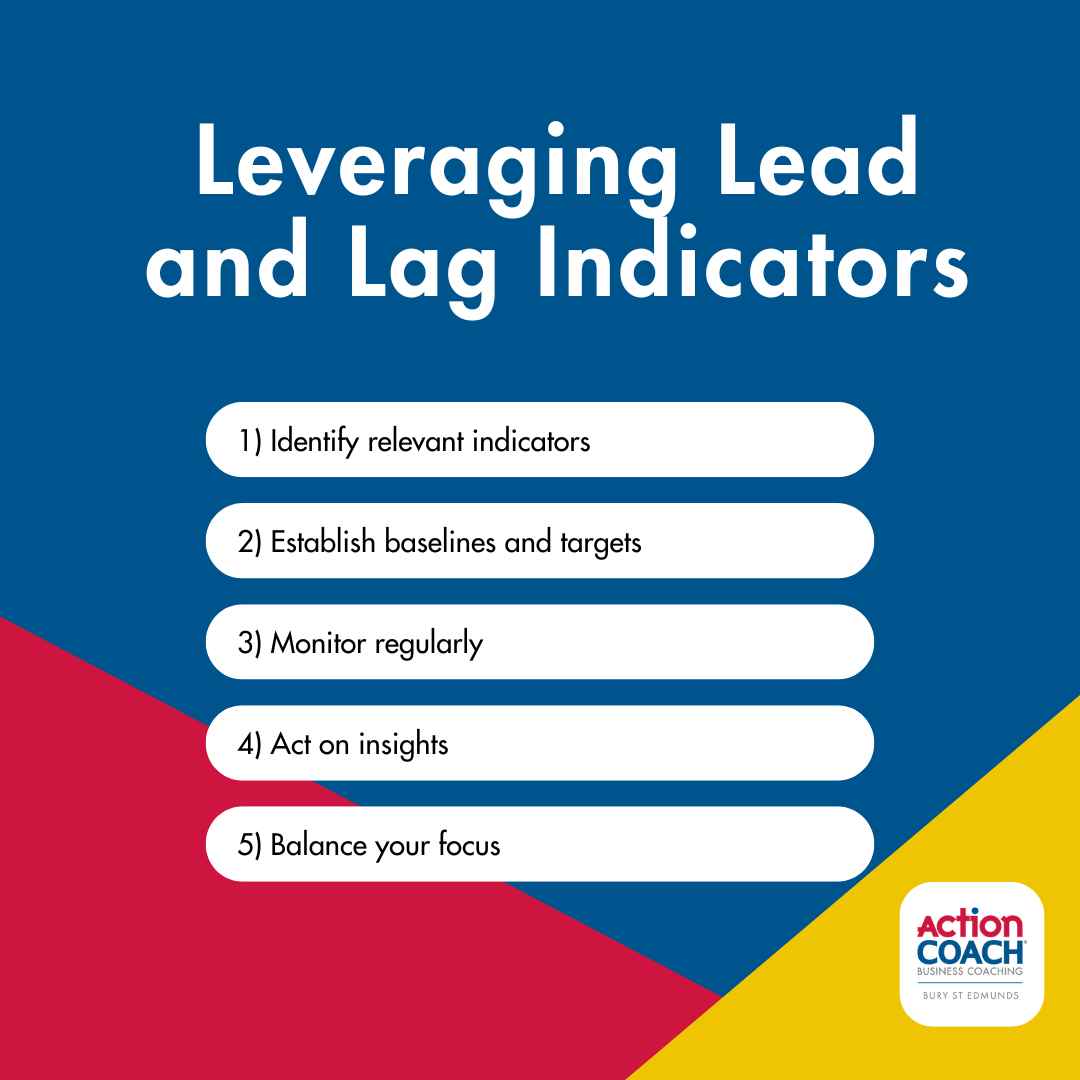Unlocking Business Performance: The Power of Leading and Lagging Indicators for UK Business Owners
Jump to:
- Understanding Leading Indicators
- Understanding Lagging indicators
- Impact on Decision-Making and Business Strategy
- How to Use Leading and Lagging Indicators to Predict and Improve Business Performance
- How to Leverage these indicators effectively
Understanding the dynamics of business performance is crucial for any business owner or manager. Two fundamental concepts in this realm are leading and lagging indicators. These indicators can significantly impact decision-making, strategic planning, and overall business success. In this blog, we will explore what leading and lagging indicators are, why they are important, and how you can leverage them to improve your business performance.
Understanding Leading Indicators
These are like the early warning signals in your business’s performance forecast. They are forward-looking metrics that help predict future trends and outcomes. Leading indicators provide insights into potential future outcomes, allowing for timely interventions and pre-emptive actions.
The Role of Leading Indicators in Predicting Future Performance
Leading indicators are essential for proactive decision-making. They allow businesses to anticipate changes, adjust strategies, and improve outcomes before problems arise. By monitoring leading indicators, UK business owners can stay ahead of the curve and ensure sustainable growth.
For example, imagine you’re running a retail business. If you notice a spike in online searches and inquiries about your products, this could be a leading indicator that your sales are about to increase. By recognising this early, you can prepare your inventory and customer service team to handle the uptick in demand, ensuring a smooth customer experience.
Other examples of Leading Indicators in Business
- Customer Satisfaction Scores: High satisfaction scores suggest that customers are pleased with your products or services and can predict repeat business and referrals.
- Employee Engagement Levels: Engaged employees are those who are highly involved in, enthusiastic about, and committed to their work and workplace, often leading to higher productivity and lower turnover rates.
- Social Media Engagement: Higher levels of engagement on social media platforms, such as likes, shares, comments, and follows, can signal growing interest in your brand and potentially translate into increased sales or customer loyalty.
- Customer Acquisition Cost (CAC): Monitoring changes in your customer acquisition cost can help predict future profitability. A decreasing CAC suggests that your marketing efforts are becoming more efficient, which can lead to higher margins and improved financial performance in the future.

Image credit: https://www.qualitygurus.com/leading-vs-lagging-indicators-explained/
Understanding Lagging Indicators
In contrast to leading indicators, lagging indicators are retrospective metrics that reflect past performance. They confirm long-term trends and are typically easier to measure but harder to influence directly. They help assess the success or failure of strategies that have already been implemented.
The Role of Lagging Indicators in Assessing Past Performance
Lagging indicators are key to evaluating the effectiveness of business strategies. They provide concrete data on what has worked and what hasn’t, allowing businesses to refine their approaches based on solid evidence.
Think of a subscription-based software company that notices its customer retention rate has been steadily declining over the past three quarters. This lagging indicator signals that customers are not renewing their subscriptions as expected. By analysing the lagging indicator of customer retention rate, the software company can make informed decisions to enhance customer satisfaction, thereby stabilising and potentially increasing future retention rates.
Other examples of Lagging Indicators in Business
- Revenue: Revenue is a lagging indicator that provides a clear picture of a company’s financial health over a defined period, such as monthly, quarterly, or annually. This metric reflects the effectiveness of the company’s sales strategies, market demand, and overall business performance.
- Profit Margins: Profit margins measure the efficiency of a company in managing its expenses relative to its revenue. Higher profit margins indicate better cost control and pricing strategies.
- Employee Turnover Rate: Employee turnover rate is a vital lagging indicator that reflects the stability of the workforce and the overall work environment. High turnover rates can indicate problems with job satisfaction, company culture, or management practices.
- Customer Lifetime Value (CLV): this measures the total revenue a business can expect from a single customer account throughout the business relationship. This metric helps businesses understand the long-term value of their customer relationships and the effectiveness of their customer retention strategies.
Resource: Employee engagement metrics: lagging and leading indicators
Impact on Decision-Making and Business Strategy
By leveraging both types of indicators, businesses can create more balanced and informed strategies. Leading indicators offer a glimpse into potential future scenarios, enabling proactive adjustments, while lagging indicators provide feedback on past strategies, guiding future improvements.
For example, if you run a restaurant, leading indicators like reservation rates and customer inquiries can help you predict busy periods and adjust staffing accordingly. Lagging indicators, such as customer reviews and revenue, will show you how well those adjustments worked.
How to Use Leading and Lagging Indicators to Predict and Improve Business Performance
Every business is unique, and the indicators that matter most will vary. Whatever the key indicators are in your business, though, neglecting these crucial metrics can lead to significant challenges:
- Missed opportunities: Without leading indicators, businesses may fail to capitalise on emerging trends or market shifts.
- Delayed responses: Relying solely on lagging indicators can result in reactive rather than proactive decision-making.
- Inefficient resource allocation: Poor understanding of performance drivers can lead to misplaced investments.
- Increased vulnerability: Failure to anticipate challenges can leave businesses exposed to market volatility.
- Stunted growth: Without a clear view of both current and future performance, sustainable growth becomes difficult to achieve.
However, leveraging both leading and lagging indicators offers numerous benefits:
- Enhanced forecasting: Leading indicators enable more accurate predictions of future performance.
- Improved decision-making: A balanced view of past and potential future performance informs better strategic choices.
- Increased agility: Early warning signs allow businesses to adapt quickly to changing market conditions.
- Optimised operations: Identifying key performance drivers helps streamline processes and improve efficiency.
- Sustainable growth: The ability to anticipate opportunities and challenges while learning from past performance fosters long-term success.

How to Leverage these indicators effectively
Effectively leveraging leading and lagging indicators requires a strategic approach tailored to your business goals and industry context. Here’s a more detailed guide to help you make the most of these powerful metrics:
- Identify relevant indicators: Your selected metrics should directly align with your business objectives and the specifics of your industry
- Establish baselines and targets: Determine what constitutes ‘good’ performance for each indicator based on historical data and industry benchmarks.
- Monitor regularly: Consistently track your chosen indicators and look for patterns or significant changes.
- Act on insights: Data is only valuable if it informs action. Use leading indicators to make proactive decisions and lagging indicators to evaluate and refine your strategies.
- Balance your focus: While leading indicators provide foresight, lagging indicators offer hindsight. A balanced approach ensures comprehensive performance management.
Conclusion
By effectively leveraging leading and lagging indicators, you can gain a holistic view of your business performance. This balanced approach not only helps you predict and prepare for future challenges but also allows you to learn from past experiences. Start by identifying the right indicators, establishing clear baselines and targets, and monitoring them consistently. Act on the insights you gather, and always strive to balance your focus between prediction and evaluation. This strategic use of indicators will empower you to make informed decisions, drive sustainable growth, and maintain a competitive edge in your industry.
Are you ready to take the next step?
Martin Baillie is a Business Coach and Growth Specialist at ActionCOACH Bury St Edmunds, committed to working with business owners to create sustainable, viable, profitable entities within the local community, and creating 1000 new jobs in the East Anglian region through that growth.
If you are looking to increase the profit in your business while freeing up time, and having a better work/life balance, there is no better time to start than now. Our business growth methodology is tried and tested, and we guarantee your results.
Contact Martin Baillie, ActionCOACH Bury St Edmunds now on Tel: 01284 334098. You can also follow him on LinkedIn, Instagram and Facebook





